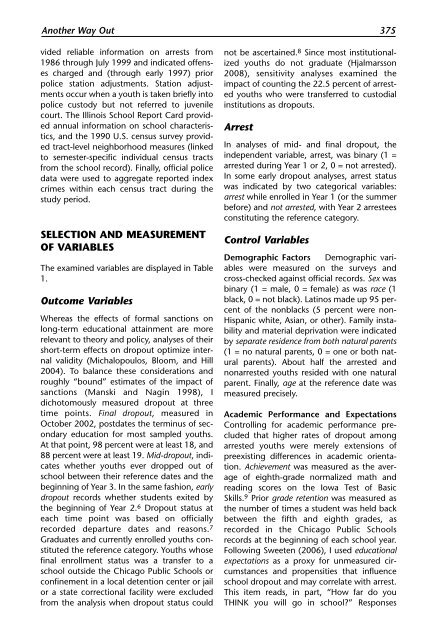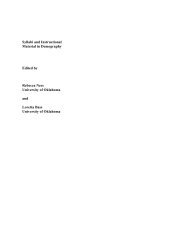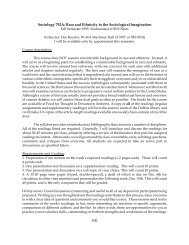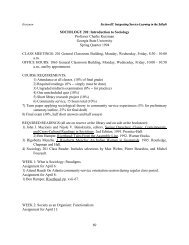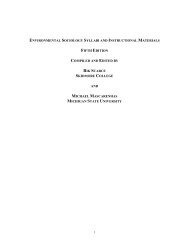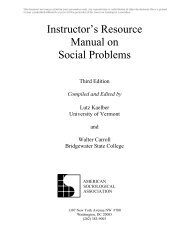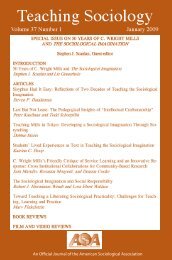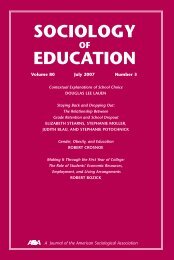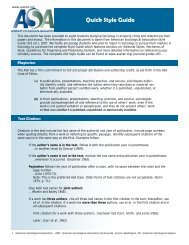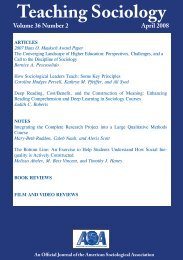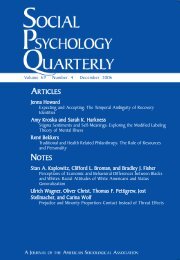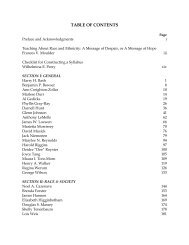SOCIOLOGY EDUCATION - American Sociological Association
SOCIOLOGY EDUCATION - American Sociological Association
SOCIOLOGY EDUCATION - American Sociological Association
Create successful ePaper yourself
Turn your PDF publications into a flip-book with our unique Google optimized e-Paper software.
Another Way Out 375<br />
vided reliable information on arrests from<br />
1986 through July 1999 and indicated offenses<br />
charged and (through early 1997) prior<br />
police station adjustments. Station adjustments<br />
occur when a youth is taken briefly into<br />
police custody but not referred to juvenile<br />
court. The Illinois School Report Card provided<br />
annual information on school characteristics,<br />
and the 1990 U.S. census survey provided<br />
tract-level neighborhood measures (linked<br />
to semester-specific individual census tracts<br />
from the school record). Finally, official police<br />
data were used to aggregate reported index<br />
crimes within each census tract during the<br />
study period.<br />
SELECTION AND MEASUREMENT<br />
OF VARIABLES<br />
The examined variables are displayed in Table<br />
1.<br />
Outcome Variables<br />
Whereas the effects of formal sanctions on<br />
long-term educational attainment are more<br />
relevant to theory and policy, analyses of their<br />
short-term effects on dropout optimize internal<br />
validity (Michalopoulos, Bloom, and Hill<br />
2004). To balance these considerations and<br />
roughly “bound” estimates of the impact of<br />
sanctions (Manski and Nagin 1998), I<br />
dichotomously measured dropout at three<br />
time points. Final dropout, measured in<br />
October 2002, postdates the terminus of secondary<br />
education for most sampled youths.<br />
At that point, 98 percent were at least 18, and<br />
88 percent were at least 19. Mid-dropout, indicates<br />
whether youths ever dropped out of<br />
school between their reference dates and the<br />
beginning of Year 3. In the same fashion, early<br />
dropout records whether students exited by<br />
the beginning of Year 2. 6 Dropout status at<br />
each time point was based on officially<br />
recorded departure dates and reasons. 7<br />
Graduates and currently enrolled youths constituted<br />
the reference category. Youths whose<br />
final enrollment status was a transfer to a<br />
school outside the Chicago Public Schools or<br />
confinement in a local detention center or jail<br />
or a state correctional facility were excluded<br />
from the analysis when dropout status could<br />
not be ascertained. 8 Since most institutionalized<br />
youths do not graduate (Hjalmarsson<br />
2008), sensitivity analyses examined the<br />
impact of counting the 22.5 percent of arrested<br />
youths who were transferred to custodial<br />
institutions as dropouts.<br />
Arrest<br />
In analyses of mid- and final dropout, the<br />
independent variable, arrest, was binary (1 =<br />
arrested during Year 1 or 2, 0 = not arrested).<br />
In some early dropout analyses, arrest status<br />
was indicated by two categorical variables:<br />
arrest while enrolled in Year 1 (or the summer<br />
before) and not arrested, with Year 2 arrestees<br />
constituting the reference category.<br />
Control Variables<br />
Demographic Factors Demographic variables<br />
were measured on the surveys and<br />
cross-checked against official records. Sex was<br />
binary (1 = male, 0 = female) as was race (1<br />
black, 0 = not black). Latinos made up 95 percent<br />
of the nonblacks (5 percent were non-<br />
Hispanic white, Asian, or other). Family instability<br />
and material deprivation were indicated<br />
by separate residence from both natural parents<br />
(1 = no natural parents, 0 = one or both natural<br />
parents). About half the arrested and<br />
nonarrested youths resided with one natural<br />
parent. Finally, age at the reference date was<br />
measured precisely.<br />
Academic Performance and Expectations<br />
Controlling for academic performance precluded<br />
that higher rates of dropout among<br />
arrested youths were merely extensions of<br />
preexisting differences in academic orientation.<br />
Achievement was measured as the average<br />
of eighth-grade normalized math and<br />
reading scores on the Iowa Test of Basic<br />
Skills. 9 Prior grade retention was measured as<br />
the number of times a student was held back<br />
between the fifth and eighth grades, as<br />
recorded in the Chicago Public Schools<br />
records at the beginning of each school year.<br />
Following Sweeten (2006), I used educational<br />
expectations as a proxy for unmeasured circumstances<br />
and propensities that influence<br />
school dropout and may correlate with arrest.<br />
This item reads, in part, “How far do you<br />
THINK you will go in school?” Responses


